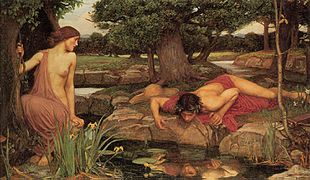User:Netherzone/sandbox/Springs (notes)
Notes on Springs[edit]
Types of springs[edit]
![]() Done
Done
- Perennial or permanent
- Intermittent or temporary
- Periodic (as in geysers)
Mineral springs[edit]
![]() DoneTypes: sulphur springs; borax springs; gypsum springs; saline springs; radium springs (or radioactive springs); iron springs; Petrifying well
DoneTypes: sulphur springs; borax springs; gypsum springs; saline springs; radium springs (or radioactive springs); iron springs; Petrifying well
Carbonated springs[edit]
![]() Done Sometimes called bubbling springs or boiling springs
Done Sometimes called bubbling springs or boiling springs
Spring-fed lakes[edit]
- pool springs, swimming holes
Cavern springs[edit]
![]() Done Solution tubular springs; Lava tubular springs
Done Solution tubular springs; Lava tubular springs
Fault dam springs[edit]
Rock dam springs; Fracture springs
Thermal springs[edit]

Classification of hot spring and warm spring per NOAA. Hot springs; spa towns; Mud volcanoes; Volcanic springs; Geysers
Flora and fauna[edit]
Diatoms, bacteria, fungal mats, microorganisms, aquatic insects, extremophiles, molluscs
Springs and settlements[edit]
archaeological record, artifacts, etc.
Alternate names[edit]
Water hole; ojo; spa; well head; fount; Cenote - are all cenotes classified as sinkholes or are some springs?
Cultural representations[edit]
![]() Done
Springs have been represented in culture through art, mythology and folklore throughout history. The Fountain of Youth is a mythical spring, which was said to restore youth to anyone who drank from it.[1] It has been claimed that the fountain is located in St. Augustine, Florida, and was discovered by Juan Ponce de León in 1513, though it has not demonstrated the power to restore youth and most historians dispute the veracity of Ponce de León's discovery.[2][3]
Done
Springs have been represented in culture through art, mythology and folklore throughout history. The Fountain of Youth is a mythical spring, which was said to restore youth to anyone who drank from it.[1] It has been claimed that the fountain is located in St. Augustine, Florida, and was discovered by Juan Ponce de León in 1513, though it has not demonstrated the power to restore youth and most historians dispute the veracity of Ponce de León's discovery.[2][3]
Pythia, also known as the Oracle at Delphi was the high priestess of the Temple of Apollo. She delivered prophesies in a frenzied state of divine possession that were "induced by vapours rising from a chasm in the rock". It is beleived that the vapors were emitted from the Kerna spring at Delphi.[4][5]
The Greek myth of Narcissus describes a young man who fell in love with his reflection in the still pool of a spring. Narcissus gazed into "an unmuddied spring, silvery from its glittering waters, which neither shepherds nor she-goats grazing on the mountain nor any other cattle had touched, which neither bird nor beast nor branch fallen from a tree had disturbed." (Ovid)[6]
The early 20th c. American photographer, James Reuel Smith created a comprehensive series of photographs documenting the historical springs of New York City before they were capped by the city after the advent of the municipal water system.[7] Smith later photographed springs in Europe leading to his book, Springs and Wells in Greek and Roman Literature, Their Legends and Locations (1922).[8][9] The book covered various regions in Italy and Greece including Peloponnesus, Central Greece, Magna Graecia, Greek Islands and Asia Minor, as well as other countriesEurope, Africa and the Middle East.[9][10][1]
The 19th c. Japanese artists Utagawa Hiroshige and Utagawa Toyokuni III created a series of wood-block prints, Two Artists Tour the Seven Hot Springs (Sōhitsu shichitō meguri) in 1854.[11]
-
John William Waterhouse Echo And Narcissus (1903)
-
Lucas Cranach, Der Jungbrunnen (Fountain of Youth), (1546)
-
Japanese woodblock print (1854), Sokokura, from the series Two Artists Tour the Seven Hot Springs (Sōhitsu shichitō meguri) by Utagawa Toyokuni III and Utagawa Hiroshige, 1854
-
Oracle of Delphi, red-figure kylix, 440-430 BC, Kodros Painter, depicting Pythia with a cup presumably holding water from a spring]]
-
A Woman Drinks at the Carmen Spring, on West 175th Street and Amsterdam Avenue, New York City, by James Reuel Smith, C. 1897-1902
Sources[edit]
- Bryan, Kirk. “Classification of Springs.” The Journal of Geology, vol. 27, no. 7, The University of Chicago Press, 1919, pp. 522–61, http://www.jstor.org/stable/30058415.
- Vashisht, A. K., and H. C. Sharma. “Study on Hydrological Behaviour of a Natural Spring.” Current Science, vol. 93, no. 6, Temporary Publisher, 2007, pp. 837–40, http://www.jstor.org/stable/24099131.
- ^ Sowers, Lloyd (2021-10-25). "Water from St. Pete's famed Fountain of Youth contained high levels of lithium". FOX 13 News. Retrieved 2021-11-11.
- ^ Connolly, Patrick (November 5, 2020). "St. Augustine Fountain of Youth may be Florida's oldest attraction". orlandosentinel.com. Retrieved 2021-11-11.
{{cite web}}: CS1 maint: url-status (link) - ^ Shaer, Matthew (June 2013). "Ponce De Leon Never Searched for the Fountain of Youth". Smithsonian Magazine. Retrieved 2021-11-11.
{{cite web}}: CS1 maint: url-status (link) - ^ Broad, William J. (19 March 2002). "For Delphic Oracle, Fumes and Visions". The New York Times. Retrieved 13 November 2021.
- ^ Hale, John R.; de Boer, Jelle Zeilinga; Chanton, Jeffrey P.; Spiller, Henry A. (August 2003). "Questioning the Delphic Oracle". Scientific American. 289 (2): 66–73. Retrieved 13 November 2021.
- ^ Nelson, Max (April–May 2000). "Narcissus: Myth and Magic". The Classical Journal. 95 (4): 363–389. Retrieved 13 November 2021.
- ^ "James Reuel Smith springs and wells photograph collection 1893–1902 – Brooklyn collection". New York Historical Society digital collection. Retrieved 13 November 2021.
- ^ Cite error: The named reference
NYHS Digital Collectionwas invoked but never defined (see the help page). - ^ a b Smith, James Reuel (1922). Springs and Wells in Greek and Roman Literature. New York and London: G.P. Putnam's Sons. Retrieved 13 November 2021.
- ^ Smith, James Reuel (1922). Springs and wells in Greek and Roman Literature: Their Legends and Locations. New York: G.P. Putnam's Sons. Retrieved 13 November 2021.
- ^ "Sokokura, from the series Two Artists Tour the Seven Hot Springs (Sōhitsu shichitō meguri)". Fine Arts Museum of San Francisco. Retrieved 13 November 2021.




![Oracle of Delphi, red-figure kylix, 440-430 BC, Kodros Painter, depicting Pythia with a cup presumably holding water from a spring]]](http://upload.wikimedia.org/wikipedia/commons/thumb/a/a3/Oracle_of_Delphi%2C_red-figure_kylix%2C_440-430_BC%2C_Kodros_Painter%2C_Berlin_F_2538%2C_141668.jpg/180px-Oracle_of_Delphi%2C_red-figure_kylix%2C_440-430_BC%2C_Kodros_Painter%2C_Berlin_F_2538%2C_141668.jpg)
